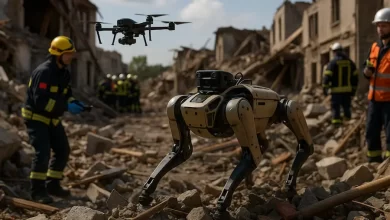AI and Robotics in Disaster Response: Saving Lives with Technology


The blog post AI and Robotics in Disaster Response: Saving Lives with Technology explores the transformative role of AI disaster response in crisis management. It begins by outlining the fundamentals of AI and robotics within disaster scenarios, particularly how rescue robots enhance efficiency in locating and assisting victims during emergencies. The article further delves into emerging trends in crisis prediction technology, emphasizing the advancements that enable timely intervention. With practical strategies for integrating humanitarian tech into real-world applications, the post provides insights on how technology can streamline response efforts and bolster rescue operations. Ultimately, it highlights the vital importance of adopting innovative solutions to save lives during disasters, demonstrating that AI disaster response can significantly improve outcomes in critical situations.
Understanding AI and Robotics in Disaster Response



As the frequency and severity of natural disasters continue to rise, the necessity for efficient and effective response mechanisms becomes increasingly crucial. AI disaster response systems are revolutionizing how organizations approach crisis situations. These technologies enhance traditional humanitarian tech by providing real-time analytics, advanced data processing, and automated systems that improve response times and overall effectiveness. Utilizing AI in disaster scenarios allows for better resource allocation, faster search and rescue missions, and ultimately, the saving of lives.
Key Aspects of AI Disaster Response
- Real-time Data Processing: Analyzing vast amounts of information rapidly to understand the situation on the ground.
- Predictive Analytics: Anticipating potential hazards and outcomes to enable proactive measures.
- Autonomous Robotics: Deploying drones and robots to perform tasks in hazardous environments without risking human lives.
- Resource Management: Optimizing the deployment of personnel and supplies based on real-time needs and assessments.
- Communication Networks: Establishing reliable channels for coordination among various humanitarian teams.
- Post-disaster Analysis: Utilizing AI to learn from past responses and improve future operations.
The intersection of AI and robotics within disaster response efforts not only increases operational efficiency but also enhances situational awareness amid chaos. For example, drones equipped with AI can survey affected areas, providing critical data that informs decision-making processes for rescue operations. Humanitarian tech is thus further augmented through the integration of sophisticated algorithms and machine learning, enabling responders to adapt to the evolving landscape of emergencies.
Moreover, collaboration among technology developers, humanitarian organizations, and governmental bodies is essential to fully realize the potential of AI in disaster response. Ensuring that these technologies are accessible, affordable, and ethically deployed can facilitate a cohesive approach to disaster management. The future of disaster response lies in embracing these technological advancements that not only prepare us for the worst but also augment our ability to respond effectively and compassionately during crises.
The Role of Rescue Robots in Crisis Situations



In recent years, the integration of rescue robots into disaster response efforts has transformed how we approach crisis situations. These advanced machines, powered by sophisticated emergency AI systems, are engineered to operate in hazardous environments where human responders might face significant risks. As natural disasters continue to rise in frequency and severity due to climate change and other factors, the demand for effective, efficient, and safe rescue operations has prompted innovations in robotics and artificial intelligence.
| Type of Rescue Robot | Key Features | Common Use Cases |
|---|---|---|
| Search and Rescue Drones | High-resolution cameras, thermal imaging | Disaster area surveying, locating survivors |
| Ground Robots | Terrain navigation, obstacle avoidance | Carrying supplies, delivering medical aid |
| Underwater Robots | Depth-rated, sonar capabilities | Searching for missing people in water |
| Exoskeletons | Body-support, load-bearing | Assisting human responders with heavy lifting |
Deploying rescue robots in crisis situations requires strategic planning and execution. Agencies engaged in disaster response must consider various factors that enable the effective utilization of these technologies. For instance, understanding the specific needs of a disaster zone, the types of robots available, and the associated costs are vital for effective management. Emergency AI systems play a critical role in ensuring these robots are operational, capable of processing data and making real-time decisions to assist response teams.
Steps for Effective Deployment of Rescue Robots
- Assess situational needs and operational goals.
- Select the appropriate type of rescue robots based on the environment.
- Establish reliable communication channels among the response team.
- Train personnel on how to operate and troubleshoot robots.
- Integrate AI systems to enhance decision-making capabilities.
- Conduct pre-deployment testing to ensure functionality.
- Gather feedback and refine strategies for future deployments.
The success of rescue robots has been evident in numerous crisis situations, showcasing their capabilities in life-saving missions. These robots are designed to not only enhance the efficiency of response teams but also ensure the safety of human personnel during critical operations. As organizations witness the advancements in robotic technology, they are more inclined to incorporate these systems into their strategic plans, fostering a future where AI disaster response becomes an integral part of emergency management.
Success Stories of Rescue Robots
Various case studies highlight the remarkable success of rescue robots in real-life crisis situations. For example, during the aftermath of natural disasters like earthquakes, robotic systems have been deployed to locate and assist trapped individuals, enabling quicker rescues. Additionally, in urban settings plagued by severe flooding, underwater drones have successfully conducted search-and-rescue operations where visibility was poor for human divers. These instances epitomize how rescue robots not only support humanitarian efforts but also reinforce safety and efficiency in challenging scenarios.
Emerging Trends in Crisis Prediction Technology
The integration of AI disaster response technologies is transforming how we approach crisis management and disaster preparedness. As the complexity of emergencies increases, so does the necessity for advanced tools that can accurately predict and respond to crises. Recent innovations in crisis prediction technology promise to enhance preparedness and minimize the impact of disasters, enabling quicker and more effective responses. This shift not only leverages powerful data analytics and machine learning but also fosters collaboration among various stakeholders, including governmental bodies and humanitarian organizations.
Advantages of Emergency AI Systems
- Real-time data analysis for rapid decision-making.
- Predictive modeling to anticipate disaster scenarios.
- Automation of resource allocation during emergencies.
- Enhanced communication systems for coordinating rescue efforts.
- Reduction of human error in crisis response.
- Improved situational awareness through data visualization.
- Cost-effectiveness by optimizing resource use.
As we delve deeper into the impact of these technologies, it’s clear that the future of disaster response is heavily reliant on effective crisis prediction. For instance, using AI-driven analytics, organizations can assimilate vast amounts of data from various sources—such as satellite imagery and social media—to identify potential crisis hotspots before a disaster occurs. This capability not only allows for better-preparedness strategies but also promotes community resilience by educating populations about potential risks associated with emerging threats.
Impact of Crisis Prediction
The potential of AI disaster response systems lies in their ability to create a proactive rather than reactive approach to emergencies. By harnessing the power of advanced algorithms, key stakeholders can develop predictive analytics that inform evacuation plans and resource distribution long before a crisis strikes. This foresight not only saves lives but also facilitates more effective collaboration among agencies responsible for public safety. In essence, the evolution of crisis prediction technologies marks a significant step toward a safer, more prepared global community poised to tackle the challenges ahead.
Actionable Strategies for Implementing Humanitarian Tech
To effectively leverage humanitarian tech in disaster response, organizations must focus on actionable strategies that enhance their operational capabilities. One key element is the integration of emergency AI systems, which can significantly streamline communication and data management during crises. This involves training responders on using these systems, ensuring robust data collection, and enabling real-time analytics to inform decision-making processes. With the ability to process vast amounts of information quickly, these technologies can help prioritize resource allocation and improve the speed of response efforts.
Steps to Enhance Disaster Response with Technology
- Assess current technological resources and identify gaps.
- Invest in training for personnel on AI disaster response systems.
- Develop partnerships with tech firms specializing in humanitarian tech.
- Implement pilot programs to test new technologies in controlled environments.
- Gather feedback from field responders to refine and enhance systems.
- Establish protocols for data-sharing and collaboration across organizations.
- Continuously evaluate and update technology solutions based on emerging needs.
These steps will help organizations not only prepare for disasters but also improve their overall efficacy when responding to emergencies. By harnessing the power of technology, responders can significantly reduce response times and ultimately save more lives. Organizations must stay proactive in adopting new innovations and ensuring that their teams are fully equipped to use these powerful tools effectively.
Briefing Document:
AI and Robotics in Disaster Response
Executive Summary
This briefing document summarizes the key themes and important ideas presented in the provided source regarding the transformative role of Artificial Intelligence (AI) and robotics in disaster response. The source highlights how these technologies enhance efficiency, improve safety, enable proactive measures, and ultimately save lives in crisis situations. It emphasizes the shift from reactive to proactive disaster management through advancements in real-time data processing, predictive analytics, autonomous systems, and strategic collaboration.
Main Themes and Key Ideas
1. The Transformative Role of AI and Robotics in Crisis Management
The central theme is that AI and robotics are revolutionizing how organizations approach crisis situations. The increasing frequency and severity of natural disasters necessitate efficient and effective response mechanisms, and AI disaster response systems are filling this crucial need.
- Enhancing Traditional Humanitarian Tech: AI “augments” traditional humanitarian efforts by providing “real-time analytics, advanced data processing, and automated systems that improve response times and overall effectiveness.”
- Life-Saving Potential: The ultimate goal is to “save lives during disasters,” as AI significantly improves outcomes in critical situations.
2. Key Aspects of AI Disaster Response
The source outlines several fundamental ways AI enhances disaster response:
- Real-time Data Processing: “Analyzing vast amounts of information rapidly to understand the situation on the ground.”
- Predictive Analytics: “Anticipating potential hazards and outcomes to enable proactive measures.” This shifts the approach from reactive to proactive.
- Autonomous Robotics: “Deploying drones and robots to perform tasks in hazardous environments without risking human lives.”
- Resource Management: “Optimizing the deployment of personnel and supplies based on real-time needs and assessments.”
- Communication Networks: “Establishing reliable channels for coordination among various humanitarian teams.”
- Post-disaster Analysis: “Utilizing AI to learn from past responses and improve future operations.”
3. The Crucial Role of Rescue Robots
Rescue robots are presented as a cornerstone of modern disaster response, designed to operate in hazardous environments where human intervention is risky.
- Safety for Responders: These machines “are engineered to operate in hazardous environments where human responders might face significant risks,” thereby “ensur[ing] the safety of human personnel during critical operations.”
- Diverse Applications: Different types of robots serve specific functions:
- Search and Rescue Drones: For “disaster area surveying, locating survivors.”
- Ground Robots: For “carrying supplies, delivering medical aid.”
- Underwater Robots: For “searching for missing people in water.”
- Exoskeletons: For “assisting human responders with heavy lifting.”
- Real-world Successes: The article cites examples such as robotic systems locating trapped individuals after earthquakes and underwater drones conducting search-and-rescue in floods, demonstrating how they “not only support humanitarian efforts but also reinforce safety and efficiency in challenging scenarios.”
- Effective Deployment: Strategic planning is vital for their use, including assessing needs, selecting appropriate robots, establishing communication, training personnel, and integrating AI systems for enhanced decision-making.
4. Emerging Trends in Crisis Prediction Technology
A significant focus is placed on the shift towards proactive disaster management through advanced crisis prediction.
- Proactive Approach: “The potential of AI disaster response systems lies in their ability to create a proactive rather than reactive approach to emergencies.”
- Data-Driven Foresight: AI-driven analytics can “assimilate vast amounts of data from various sources—such as satellite imagery and social media—to identify potential crisis hotspots before a disaster occurs.”
- Advantages of Emergency AI Systems for Prediction: These include “real-time data analysis for rapid decision-making,” “predictive modeling to anticipate disaster scenarios,” and “automation of resource allocation.”
- Societal Impact: This capability allows for “better-preparedness strategies” and “promotes community resilience by educating populations about potential risks.”
5. Actionable Strategies for Implementing Humanitarian Tech
The source outlines practical steps for organizations to effectively integrate and leverage AI and robotics in their disaster response efforts.
- Strategic Integration: Organizations must focus on “actionable strategies that enhance their operational capabilities,” with a key element being the integration of “emergency AI systems, which can significantly streamline communication and data management during crises.”
- Key Implementation Steps:Assess and Identify Gaps: Evaluate current technological resources.
- Invest in Training: Crucial for personnel to effectively use AI disaster response systems.
- Partnerships: Collaborate with tech firms specializing in humanitarian tech.
- Pilot Programs: Test new technologies in controlled environments.
- Feedback Loop: Gather feedback from field responders for refinement.
- Data Sharing & Collaboration: Establish protocols for inter-organizational cooperation.
- Continuous Evaluation: Regularly update solutions based on emerging needs.
- Overall Impact: By following these steps, organizations can “significantly reduce response times and ultimately save more lives.”
Conclusion
The article strongly advocates for the widespread adoption of AI and robotics in disaster response, portraying them as indispensable tools for the future of emergency management. The integration of these technologies promises not only increased operational efficiency and improved situational awareness but also a fundamental shift towards a more proactive and prepared global community, ultimately saving lives and mitigating the impact of disasters. Collaboration among technology developers, humanitarian organizations, and governmental bodies is presented as essential to fully realize this potential.
Artificial intelligence / humanaifuture.com
🎧 Listen to the Podcast
Want to explore this topic in more depth? Listen to the full podcast for more insights and expert commentary.
▶️ Play on Google DriveNo sign-up needed — just click and listen.
What are the key aspects of AI in disaster response
Key aspects of AI disaster response include:
- Real-time Data Processing: Rapid analysis of vast amounts of information to understand the situation on the ground.
- Predictive Analytics: Anticipating potential hazards and outcomes to enable proactive measures.
- Autonomous Robotics: Deploying drones and robots to perform tasks in hazardous environments without risking human lives.
- Resource Management: Optimizing the deployment of personnel and supplies based on real-time needs and assessments.
- Communication Networks: Establishing reliable channels for coordination among various humanitarian teams.
- Post-disaster Analysis: Utilizing AI to learn from past responses and improve future operations.
How do rescue robots contribute to crisis situations?
Rescue robots, powered by sophisticated emergency AI systems, are engineered to operate in hazardous environments where human responders face significant risks. They enhance the efficiency of response teams and ensure the safety of human personnel. Examples include high-resolution camera drones for surveying disaster areas, ground robots for carrying supplies, underwater robots for searching in water, and exoskeletons for assisting human responders with heavy lifting.
What steps are crucial for the effective deployment of rescue robots?
Effective deployment of rescue robots involves:
- Assessing situational needs and operational goals.
- Selecting the appropriate type of rescue robots based on the environment.
- Establishing reliable communication channels among the response team.
- Training personnel on how to operate and troubleshoot robots.
- Integrating AI systems to enhance decision-making capabilities.
- Conducting pre-deployment testing to ensure functionality.
- Gathering feedback and refining strategies for future deployments.
What are emerging trends in crisis prediction technology?
Emerging trends in crisis prediction technology focus on enhancing preparedness and minimizing disaster impact through AI-driven analytics. These technologies leverage powerful data analytics and machine learning to assimilate vast amounts of data from sources like satellite imagery and social media. This allows organizations to identify potential crisis hotspots before a disaster occurs, leading to a more proactive rather than reactive approach to emergencies.
What are the advantages of using emergency AI systems for crisis prediction?
Emergency AI systems offer several advantages for crisis prediction, including:
- Real-time data analysis for rapid decision-making.
- Predictive modeling to anticipate disaster scenarios.
- Automation of resource allocation during emergencies.
- Enhanced communication systems for coordinating rescue efforts.
- Reduction of human error in crisis response.
- Improved situational awareness through data visualization.
- Cost-effectiveness by optimizing resource use.
What actionable strategies can organizations implement to leverage humanitarian tech?
To effectively leverage humanitarian tech, organizations should focus on:
- Assessing current technological resources and identifying gaps.
- Investing in training for personnel on AI disaster response systems.
- Developing partnerships with tech firms specializing in humanitarian tech.
- Implementing pilot programs to test new technologies in controlled environments.
- Gathering feedback from field responders to refine and enhance systems.
- Establishing protocols for data-sharing and collaboration across organizations.
- Continuously evaluating and updating technology solutions based on emerging needs.
How does collaboration among stakeholders contribute to the success of AI in disaster response?
Collaboration among technology developers, humanitarian organizations, and governmental bodies is essential to fully realize the potential of AI in disaster response. Ensuring these technologies are accessible, affordable, and ethically deployed facilitates a cohesive approach to disaster management. This collaborative effort helps develop predictive analytics, inform evacuation plans, and optimize resource distribution, ultimately leading to a safer and more prepared global community.




